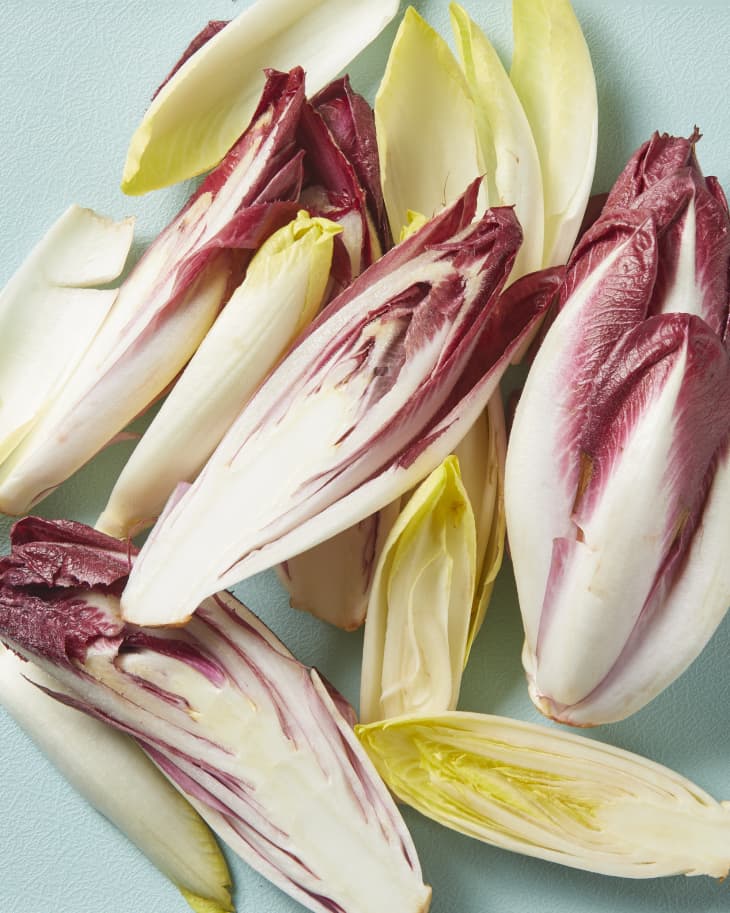What Is Endive Exactly? How to Cook with the Leafy Vegetable
Endives are a bit of a mystery in the vegetable world. Although they may have been tucked into your salad once or twice, do you know exactly what they are? Or how they are different from lettuce? We’ve got answers, including how to tell the varieties apart and how best to enjoy the versatile vegetable.
What Is an Endive?
An endive is a bitter, crunchy leaf vegetable from the chicory family. It most commonly appears as the white, oblong Belgian endive with light green ends or the slightly milder red endive. Endive is best enjoyed with sweet, creamy, or acidic foods to balance out its bitter taste. It’s common to serve endive as an appetizer with something on top of it.
What Is an Endive?
While an endive’s crispy, crunchy stalks may look a bit like lettuce, the vegetable is actually categorized separately as a naturally bitter, leafy perennial plant from the Cichorium (chicory) genus and Asteraceae family. The first endives are believed to have originated in Egypt and Indonesia, making their way to Europe in the 16th century. In a somewhat confusing move, endive can be known by different names — chicory, chicon, witloof, curly endive, escarole, and frisée, to name a few — depending on where it is cultivated and enjoyed. To simplify, it’s easiest to think of all of these plants as close cousins with slightly different tastes and colors.
What Are the Different Types of Endive?
- Belgian endive (also known as white endive): This European-cultivated plant is perhaps the best-known variety of endive. While there are multiple reported origin stories — including one about how Belgian endive comes from a chicory farmer who forgot to pull up his chicory root, resulting in the sprouted endive — it can only be confirmed that the variety first appeared in Belgium in the 1800s. Belgian endives have tightly packed, firm, pale leaves with a slight green end and a moderately bitter flavor.
- Red endive: The Belgian endive’s milder-tasting cousin — this endive appears as a cross between another Cichorium (radicchio) and the white endive, with the same firm leaves as the white endive, but a deep red-purple color.
- Escarole (also known as broad leaf or Batavian endive): An endive with wide, curly green leaves and a mild flavor, this variety appears most commonly in place of lettuce in salads or incorporated into soups.
- Frisée (also known as curly endive): A sub-version of the escarole endive, with smaller leaves and an equally mild taste that works well in salads.
How Is Endive Grown?
While escarole and frisée are harvested similarly to lettuce, Belgian and red endive are grown in a unique, two-step process. First planted in fields for 150 days to develop the root and leaves, the endive is then moved to a cold storage facility, where its roots are periodically moved to a dark, humid, and cool room for a second growth period of 28 days. Endives are usually available year-round.
What Does Endive Taste Like?
Endive is commonly described as having a bitter flavor, although this isn’t necessarily a bad thing. The key to finding a Belgian endive that will pack just the right amount of bitter flavor is to look for a plant with leaves that are more yellow than green. As Belgian endives are exposed to light, they become more bitter — you can also counteract this by pairing your endive with bright, citrusy, salty, sweet, and creamy foods before enjoying.
How Do You Store Endive?
According to the FDA, endives are most similar to spinach, lettuce, and other leafy greens and keep well in your refrigerator’s crisper drawer for approximately three to seven days. If your endive appears slimy or has brown spots, it’s gone bad.
How Do You Prepare Endive?
Escarole and frisée can be enjoyed both raw and cooked, and should be treated similarly to other leafy greens. Belgian endive can also be enjoyed both raw and cooked — to prepare raw Belgian endive, trim the root end from the plant and peel the leaves off to separate them. Sautéing and grilling Belgian endive will mellow its bitterness.
